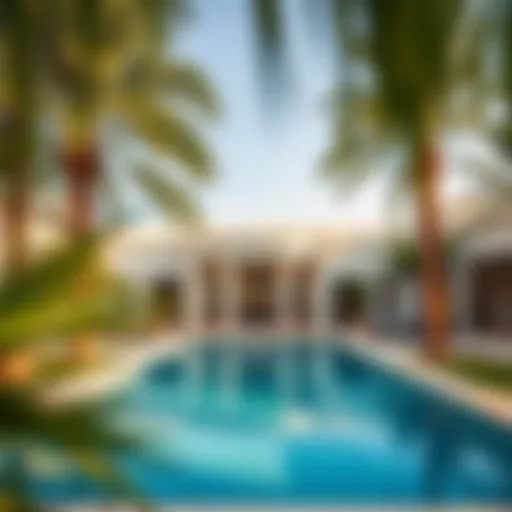Exploring Souk Al Kabeer: Cultural and Architectural Insights
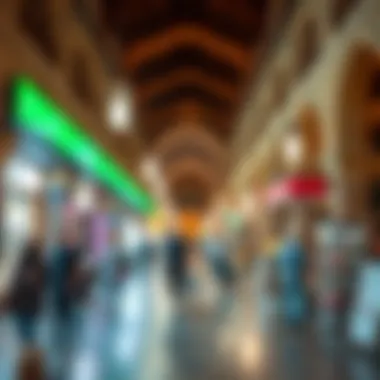

Intro
Situated in the heart of Bur Dubai, Souk Al Kabeer stands as a testament to the rich tapestry of culture and architecture that defines the area. This building isn’t just a marketplace; it embodies history, community, and evolving real estate trends. As we explore its architectural significance and cultural importance, we'll uncover layers of meaning that reveal how this landmark reflects the spirit of Dubai.
The allure of Souk Al Kabeer draws in tourists and locals alike. From its intricate design that nods to traditional Arabic influences to its bustling atmosphere filled with merchants, it acts as a hub where commerce meets culture. The vendors, the products, and the architecture of the souk contribute to an experience that extends beyond shopping. It becomes a sensory journey, a historical narrative, and an insight into Dubai's continual evolution.
However, it’s not just about what the souk offers today. A look into the historical context provides a richer understanding of its significance. In times gone by, this place was pivotal for trade routes that connected various regions, enriching the local economy and culture. The architecture, often a blend of the old and the new, showcases the transitioning phases of Dubai while retaining its roots.
As we proceed, each section will delve deeper into various aspects of Souk Al Kabeer, namely its architectural features, current market trends, and the buying and selling process within this vibrant part of Bur Dubai. So, buckle up as we embark on this detailed exploration.
Market Trends
Current Real Estate Market Overview
The real estate landscape in Bur Dubai, especially surrounding Souk Al Kabeer, is dynamic. Recent years have seen a surge in development, with investments pouring into this iconic area. The strategic location of the souk, adjacent to both residential and commercial properties, has contributed significantly to its value, consistently attracting buyers and investors.
Although global market fluctuations have affected many regions, Bur Dubai’s localized demand remains robust. Properties situated close to cultural hubs like Souk Al Kabeer tend to command higher prices due to their desirability. Affordability remains an overarching concern, but the influx of foreign investment offers opportunities for growth.
Emerging Neighborhoods and Investment Hotspots
Bur Dubai isn't merely about the souk; it encompasses several emerging neighborhoods ripe for exploration. Areas like Al Fahidi and Al Buteen are gaining traction among buyers and investors.
- Al Fahidi: Known for its historic district and art scene, it attracts a younger demographic looking for a blend of heritage and modern living.
- Al Buteen: Offers a quieter atmosphere, yet it sits close enough to the bustling activity of the souk, making it appealing for families and professionals alike.
Investors should be keen on looking at these neighborhoods as they provide varied options for different lifestyle needs. The continuous development of infrastructure, including transport links, enhances their value further.
"The proximity to Souk Al Kabeer not only boosts property values but also contributes to a vibrant community life. It plays a crucial role in the appeal of neighborhoods nearby."
In summary, the market trends surrounding Souk Al Kabeer not only highlight its current significance but also pave the way for potential future investments. Understanding these shifts in real estate can empower investors, homebuyers, and real estate enthusiasts to make informed decisions.
Buying and Selling Process
Step-by-Step Guide for Homebuyers
Navigating the purchasing process in Bur Dubai can sometimes feel like threading a needle, yet having a clear roadmap simplifies things greatly. Here’s a concise guide:
- Research the Market: Knowing market dynamics can help you spot valuable opportunities.
- Engage a Local Real Estate Agent: Their expertise is indispensable in a fast-moving market.
- View Properties: Prioritize visits to properties in areas that align with your needs; Souk Al Kabeer offers numerous options.
- Negotiate the Offer: Always be ready to negotiate on price and conditions.
- Secure Financing: Whether through local banks or financial institutions, having your financing secured is a must.
- Final Inspection and Signing Documents: Conduct a thorough inspection before finalizing the sale.
Tips for Sellers to Maximize Property Value
For sellers looking to capitalize on their investment near Souk Al Kabeer, consider these strategies:
- Enhance Curb Appeal: First impressions matter; beautifying the property could elevate value.
- Highlight Local Amenities: Showcase the benefits of living close to cultural hubs like the souk.
- Collaborate with Professionals: Enlist the help of real estate agents who understand the nuances of the local market.
- Price it Right: Proper pricing is key; align with current market trends for competitive advantage.
Understanding both the buying and selling process is essential for those looking to navigate the Bur Dubai market effectively. Armed with knowledge, the potential for successful transactions increases significantly.
Prelims to Souk Al Kabeer
Souk Al Kabeer holds a special place in the tapestry of Bur Dubai, serving as a bridge connecting the past with the present. This bustling market is not just a commercial hub but also a cultural landmark steeped in history. It offers a unique glimpse into the local traditions, architecture, and way of life that define this vibrant area of Dubai. Understanding Souk Al Kabeer is essential for anyone looking to grasp the nuances of Bur Dubai, where modernity meets historical charm.
From an investor's standpoint, the souk represents a mix of opportunity and culture. The local market dynamics, influenced by both residents and tourists, make it a focal point for entrepreneurs and real estate enthusiasts alike. Moreover, the rich architectural design, additional amenities, and ongoing developments have the potential to significantly enhance property values in the vicinity. All of these factors contribute to the importance of this section, and they will be unpacked thoroughly in the following subsections.
Geographical Context
Bur Dubai, situated on the western side of Dubai Creek, is home to the well-known Souk Al Kabeer. The geographical positioning of this market allows for easy access from various parts of the city, which is crucial for its constant foot traffic. Known for its narrow lanes and traditional marketplace atmosphere, the souk sits side by side with both modern skyscrapers and cultural landmarks like Al Fahidi Historical Neighborhood.
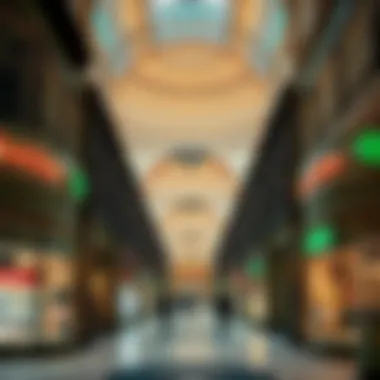

This unique blend of the old and new makes it a hotspot for visitors and locals alike, offering everything from spices to textiles. The waterfront location along the Creek not only adds to its charm but also provides opportunities for trade and commerce through its proximity to transportation routes. A stroll down its streets offers the chance to experience Dubai's maritime past while shopping for contemporary goods, further emphasizing the strategic significance of its location.
Historical Background
The history of Souk Al Kabeer is a rich narrative reflecting the evolution of Dubai from a humble trading post to a global city. Initially established in the early 20th century, the souk was a central point for traders, particularly those specialized in textiles and spices. Its name, "Al Kabeer," translates to "The Great Market," highlighting its importance as a large destination for commerce.
Over the decades, the souk has witnessed various changes, from the construction of modern infrastructure to the effects of economic booms and busts. Despite these challenges, it has retained its identity as a venue where cultural exchange occurs. Recently, efforts have been made to preserve the traditional aspects of the market while adapting it to modern shopping experiences. This blend of old and new highlights the community's desire to maintain its heritage while embracing progress, which has contributed significantly to the souk's cultural relevance in today’s Dubai.
"In Bur Dubai, Souk Al Kabeer stands not just as a market but as a guide through the metropolis' rich historical layers."
Understanding these elements—geographical and historical—sets the foundation for exploring the architectural design, cultural significance, and economic prospects that make Souk Al Kabeer a vital part of the Bur Dubai narrative.
Architectural Design and Features
Understanding the architectural design and features of Souk Al Kabeer is essential for grasping its significance in the urban landscape of Bur Dubai. This section will address the materials used in the construction, the underlying design philosophy, and how Souk Al Kabeer compares with other markets in the region. Each aspect is critical in appreciating not just its beauty but also its practicality and relevance in today’s context.
Building Materials
The construction of Souk Al Kabeer draws heavily on traditional materials that reflect both the heritage and the environmental conditions of Dubai. Predominantly, local stone, wood, and clay have been utilized, which not only align with the aesthetic but also serve functional purposes, such as natural cooling in the sweltering heat.
The choice of materials is particularly significant. The blend of limestone and gypsum used in the facades creates a timeless look, while the sturdy timber beams add structural integrity. Additionally, these materials are cost-effective and accessible, allowing builders to stay within budget without compromising quality. This ensures that Souk Al Kabeer stands as a model for sustainable architecture, honoring the past while addressing present demands.
Design Philosophy
The design philosophy of Souk Al Kabeer is intrinsically linked to traditional Emirati culture. The layout is purposefully compact, promoting easy navigation and community interaction, which makes it a vibrant hub for both locals and visitors. Unlike modern shopping malls, which often isolate the consumer in a linear shopping experience, Souk Al Kabeer encourages exploration across its winding pathways. The incorporation of shaded areas, central courtyards, and open-air spaces fosters a bustling marketplace atmosphere.
The guiding principle behind its design is to create a balance between utility and artistry. Each stall is not just a space for merchandise; it’s a platform for cultural exchange. Engaging storefronts reflect not just the goods being sold but also stories and traditions, making shopping a culturally immersive experience.
Comparison with Other Souks
When positioning Souk Al Kabeer alongside other souks like Souk Madinat Jumeirah or the bustling Gold Souk, several distinctions emerge.
- Authenticity: Souk Al Kabeer maintains a more traditional ambiance, contrasting with the more modern design elements found in newer souks.
- Diversity of Goods: While the Gold Souk specializes in…well, gold, Souk Al Kabeer offers a rainbow of items—from spices to textiles, each stall testifying to the region’s rich cultural tapestry.
- Visitor Experience: Other souks may often cater to tourists, with fixed prices and guided tours. In contrast, Souk Al Kabeer thrives on negotiation and interaction, immersing visitors in the local culture.
"In Bur Dubai, Souk Al Kabeer stands as a testament to what can be achieved when tradition meets thoughtful design."
Cultural Significance
The cultural significance of Souk Al Kabeer and its implications resonate deeply within the tapestry of Bur Dubai's historical landscape. This marketplace is not simply a commercial hub; it represents a living heritage, where age-old traditions continue to flourish amidst modernity. Its role is multifaceted, intertwining commerce, social interaction, and the preservation of cultural identity. Understanding this significance hinges on recognizing how it embodies local customs and practices while fostering community connections.
Role in Local Traditions
Souk Al Kabeer serves as the heart of many local traditions, acting as a gathering point where historical practices meet daily life. For residents of Bur Dubai, the souk is more than a place to shop; it’s a venue for various social rituals — from exchanging greetings to the sharing of local stories. Traditional crafts, spices, and textiles found here offer a glimpse into the past, reinforcing a sense of belonging and continuity.
- Cultural Exchange: Visitors and locals alike participate in cultural exchanges that breathe life into ancient practices. Events such as festivals often incorporate activities featured in the souk, promoting a rich tapestry of local heritage.
- Festive Celebrations: During major traditional holidays, Souk Al Kabeer becomes a vibrant stage for cultural displays, including folk dances and traditional music, showcasing the rich history of the Emirati people.
- Language and Dialect: The interactions within the souk are laced with local dialects, further enriching the cultural experience and fostering a communal identity among visitors.
Incorporating these elements enhances the vibrancy of the souk, making it a quintessential element of the Bur Dubai experience.
Impact on Community Identity
The impact of Souk Al Kabeer extends beyond mere commerce; it shapes and reinforces community identity. The marketplace is a living emblem of Bur Dubai's diverse population, contributing to social cohesion and a shared sense of place.
- A Meeting Point: At any given time, you might find people congregating at the souk, exchanging news, or discussing local issues. This dynamic fosters relationships among residents, creating a strong communal fabric that is vital for social harmony.
- Culinary Heritage: The food stalls offer more than just sustenance; they present a culinary narrative rich in flavors and heritage. Traditional dishes are often discussed among locals, linking generations through shared recipes and cooking techniques.
- Source of Pride: For many locals, Souk Al Kabeer is a source of pride. It stands as a testament to the resilience of their cultural heritage amidst the rapid pace of modernization affecting Dubai.
“The souk isn’t just a market; it’s a reflection of who we are and where we come from.”
In summary, the cultural significance of Souk Al Kabeer cannot be overstated. It is a vital space for transactions, social interactions, and cultural preservation, thereby reinforcing the community's identity and sustaining local traditions. As Bur Dubai continues to evolve, the souk remains steadfast, acting as a bridge that connects the past with the present.
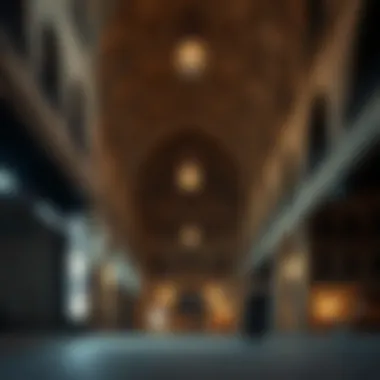

Economic Aspects
Understanding the economic framework surrounding Souk Al Kabeer is crucial for anyone looking to engage with or invest in this vibrant area of Bur Dubai. The dynamics of this market are not just relevant for those with deep pockets but also for the average buyer or seller navigating through this bustling economic hub. A thorough analysis of the economic aspects allows potential investors to grasp the intricate relationship between local market trends, investment opportunities, and property demand.
Market Trends in Bur Dubai
Market trends in Bur Dubai are a reflection of broader economic patterns within the region. As a historical trading post, Bur Dubai has consistently attracted a mix of tourists and locals alike, leading to a steady demand for retail spaces and housing. Today, several factors are influencing these trends:
- Tourism Demand: The inflow of tourists to Dubai remains a significant driver for local businesses. With Souk Al Kabeer being a key attraction, shops and eateries often see high foot traffic, especially during peak tourist seasons.
- Economic Diversification: The UAE's push towards diversifying its economy beyond oil has led to an increase in international businesses setting up in Dubai. This influx brings more potential customers to the households and small enterprises thriving around Souk Al Kabeer.
- Government Incentives: Various governmental initiatives designed to stimulate real estate investment foster an attractive environment for business owners and investors.
Overall, the market trends indicate a positive trajectory for Bur Dubai's growth, and Souk Al Kabeer stands at the heart of this evolving landscape.
Investing in Souk Al Kabeer
Investment opportunities in Souk Al Kabeer are varied and multifaceted, catering to different investor profiles. While some may lean towards retail spaces due to the high footfall, others might see potential in mixed-use developments.
- Retail Spaces: Given the mixture of local and tourist clientele, retail spaces continue to be a wise investment choice. The diverse range of shops—from traditional souks to modern boutiques—ensures a steady flow of customers, making it an appealing option.
- Residential Properties: With a growing expatriate community, demand for quality residential units remains strong. Investing in this segment, especially within walking distance of Souk Al Kabeer, could yield good returns.
- Future Developments: Investors should also take note of upcoming projects that aim to modernize the area while maintaining its traditional charm. Evolving infrastructure is likely to enhance property values in the long run.
"Investing in Souk Al Kabeer offers not just good returns but a chance to play a part in preserving its rich cultural heritage."
Property Values and Demand
The property values surrounding Souk Al Kabeer are often dictated by various factors that range from economic conditions to cultural significance. Demand for real estate in this area does not simply arise from its location but also springs from its cultural and historical relevance.
- Cultural Significance: Properties within the area benefit from being part of a historically rich community, which has considerable allure for both tourists and residents. This cultural backdrop enhances property desirability, creating stable demand.
- Affordability Trends: In contrast to other areas in Dubai, Souk Al Kabeer offers relatively affordable options, making it accessible for a diverse range of buyers. This affordability contributes to a healthy demand environment.
- Market Dynamics: Real estate market fluctuations also impact property values. Investors should be aware of seasonal shifts and trends that can lead to price increases or decreased demand, especially during economic downturns.
In summary, taking into account both current market trends and the cultural clout of Souk Al Kabeer can significantly inform real estate decisions. Investors who stay well-informed and ready to adapt to changing circumstances are likely to find opportunities that align with their investment strategy.
Visitor Experience
The experience of visiting Souk Al Kabeer is pivotal, not just for its architectural charm but also for its unique atmosphere and the myriad of interactions it offers to visitors. This vibrant marketplace serves as a bridge between the past and present, allowing tourists and locals alike to immerse themselves in the cultural heartbeat of Bur Dubai. Understanding this experience is essential for those looking to invest or engage within this area, as it reflects the broader community sentiment and lifestyle, fundamentally affecting real estate potential and market dynamics.
Amenities and Services
Souk Al Kabeer is equipped with a plethora of amenities and services designed to enhance the visitor's experience. From the moment one steps into the souk, an array of sensory stimuli greets them — the fragrant wafts of spices, the colorful displays of textiles, and the lively chatter of merchants create an enticing environment. Key amenities include:
- Information Centers: These provide insights about the souk, offering maps and details about ongoing events.
- Rest Areas: Comfortable seating areas are available for those who wish to take a breather and soak in the atmosphere.
- Accessibility Features: Ramps and smooth pathways ensure easy navigation for all visitors, including those with mobility challenges.
- Restrooms and Parking: Clean facilities are strategically placed, alongside ample parking options, making it convenient for visitors to access the souk.
The thoughtful allocation of these amenities demonstrates a commitment to visitor comfort, translating to higher foot traffic and, subsequently, increased economic activity.
Shopping and Dining Options
As a vibrant marketplace, Souk Al Kabeer boasts an eclectic mix of shopping and dining options, making it a pivotal stopping point for anyone exploring Bur Dubai. The shops here reflect the diverse cultural fabric of the region, featuring everything from traditional handicrafts to contemporary fashion items. Notable shopping options include:
- Traditional Souvenirs: Artisans sell handcrafted items that capture the essence of UAE culture, such as pottery and textiles.
- Modern Retail Stores: For those seeking the latest trends, shops offer both local and international brands, providing a rich variety of choices.
- Spice Markets: The air is thick with aromas from stalls overflowing with vibrant spices, an experience that is both delightful and educational.
Dining options within the souk also reflect its cultural tapestry. Visitors can find:
- Street Food Stalls: Tantalizing dishes that range from Shawarma to traditional Emirati delicacies, providing a taste of local flavors.
- Casual Cafes: Perfect spots to relax over a cup of mint tea or Arabic coffee, often with a view of the market bustle.
- Upscale Restaurants: For those looking for a sit-down meal, there are fine dining establishments offering gourmet versions of traditional dishes.
In summary, the visitor experience at Souk Al Kabeer is richly layered with sensory delights, making it a microcosm of Bur Dubai’s larger cultural and economic identity. As such, whether you’re a potential investor or simply a curious traveler, appreciating these elements is fundamental to understanding the value this souk brings to the broader community.
*“Souk Al Kabeer is more than just a marketplace; it's a living testament to the cultural evolution and vibrant spirit of Bur Dubai.
Future Developments
The prospects for future developments around Souk Al Kabeer hold significant importance in shaping its architectural landscape and cultural footprint within Bur Dubai. As urbanization continues to permeate the region, integrating new technological advancements with traditional elements becomes imperative. This intersection of the old and the new can provide a blueprint for sustainable and culturally sensitive development. Investors and developers alike should pay heed to these evolving possibilities as they chart the course for the future of Souk Al Kabeer.
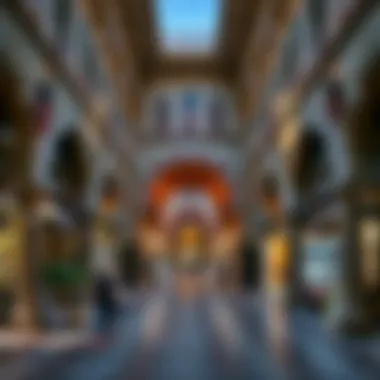

Planned Integrations into Urban Landscape
One of the focal points of future developments involves planned integrations into the urban landscape. There is potential for enhancing connectivity between Souk Al Kabeer and its surrounding areas through the construction of pedestrian walkways, public transportation systems, and green spaces. For example, envisioning an attractive promenade that connects various cultural and commercial hotspots could foster more foot traffic and engaging experiences for visitors and locals alike.
Benefits of such integrations could include:
- Increased accessibility to the souk
- Attraction of tourism due to ease of movement
- Preservation of local heritage while encouraging modern urbanity
- More community events, such as markets and festivals that can bring residents and visitors together
Furthermore, local government discussions have hinted at incorporating smart city technologies, which could improve services and enhance the overall visitor experience. Smart lighting, for example, can illuminate the paths leading to the souk, creating a safer environment while adding to its charm.
Potential for Real Estate Growth
The area surrounding Souk Al Kabeer is ripe for real estate growth. The interest from investors is magnified by the ongoing revitalization projects planned for Bur Dubai, which inherently increase property values. Such developments often see a flurry of new retail outlets, residential units, and hospitality services springing up, providing diverse living and shopping options that appeal both to residents and visitors.
As the neighborhood becomes more desirable, it's essential to consider factors influencing this potential growth:
- Infrastructural Upgrades: Enhanced road facilities and public services can lead to increased property values.
- Community Engagement: Creating venues for cultural exchanges boosts the vibrancy of the area, making it attractive for real estate investments.
- Health and Environmental Considerations: With the growing emphasis on sustainability, developers are focusing on eco-friendly projects, which tend to draw a premium among buyers.
In summary, the future of Souk Al Kabeer is not just a question of preserving its historical essence but integrating its legacy into a flourishing urban environment. The prospects of planned infrastructural changes and real estate trends foster an atmosphere ripe for investment and community involvement, establishing a dynamic hub that continues to reflect both its heritage and its aspirations.
Challenges and Opportunities
Exploring the fabric of Souk Al Kabeer involves navigating the complex terrain of challenges and opportunities this historic marketplace faces today. Understanding these factors is crucial for investors and stakeholders looking to make informed decisions regarding the properties and businesses situated here.
Cultural Preservation vs. Modernization
The balancing act between cultural preservation and modernization stands as one of the most critical challenges for Souk Al Kabeer. The site is not just a venue for trade; it is a living tapestry of heritage that tells the story of Bur Dubai. This tug-of-war often invites the scrutiny of locals and preservationists alike, who grapple with the question of how to maintain authenticity amidst the inevitable march of progress.
Local artisans often argue that modern interventions can dilute the cultural essence, while developers contend that adaptation is necessary to meet contemporary consumer demands. This duality reflects the broader global conversation about heritage versus utility, but it takes on a particular urgency in Bur Dubai, where tourism and international investment are key drivers of the economy.
For instance, recent renovations of neighboring market spaces, like the old Al Fahidi Souk, have faced backlash from cultural purists. Opponents argue that too much glass and steel can clash with traditional building styles. Consequently, it becomes important for any new project to incorporate materials and design philosophies that respect rather than erase the past. Continuing this dialogue is vital for nurturing community identity while facilitating necessary economic growth.
Regulatory Factors Affecting Development
Shifting to the practical side of the equation, regulatory factors significantly influence the trajectory of development around Souk Al Kabeer. The local government implements a series of guidelines to ensure that any expansions or renovations stay within certain aesthetic and functional parameters. Zoning laws, building codes, and conservation directives shape how stakeholders can mold the landscape.
Investors need to navigate this regulatory framework to identify viable opportunities. Some key points include:
- Government Incentives: Local authorities often provide incentives for businesses that commit to using sustainable practices or preserving historic elements in their designs.
- Compliance Costs: Meeting regulatory standards can sometimes require additional investments in construction materials and design specifications, affecting initial budgets.
- Public Sentiment: Engaging the community ensures that new developments do not just comply with regulations but also resonate with local ethos.
It's crucial to maintain an up-to-date understanding of the policies influencing development in this area. Engaging with civic leaders and getting involved in community discussions can often unveil pathways that navigate these regulations effectively.
Preserving the charm of a place like Souk Al Kabeer is no small feat; it requires collaboration among diverse stakeholders — from government officials to local business owners.
Ultimately, the interplay of cultural preservation, modernization, and regulatory standards doesn’t just determine the future of Souk Al Kabeer; it shapes the broader narrative of Bur Dubai as a whole. Investors, agents, and buyers must remain aware of how each of these factors can create opportunities in an ever-evolving marketplace.
Closure
Reflecting on the discussion about Souk Al Kabeer highlights its significance as more than just a marketplace; it stands as a pivotal cultural and architectural landmark in Bur Dubai. The integrating of historical narratives with contemporary urban development creates a multifaceted view of the souk, which is essential for not only residents but also for investors and the wider community.
Summary of Key Points
- Historical Richness: The souk's roots trace back generations, witnessing the evolution of trade and cultural exchange in Dubai. Its architectural design embodies the traditional aesthetics that have shaped local identity.
- Current Economic Landscape: As Bur Dubai evolves, so does the economic fabric surrounding Souk Al Kabeer, drawing investors with its increasing property values and demand for retail spaces.
- Cultural Engagement: Souk Al Kabeer is a living canvas of local traditions, offering visitors authentic shopping and dining experiences that reflect the region's heritage. The market serves as a hub for community gatherings and social events, enhancing its cultural significance.
- Future Growth Potential: With planned developments and urban integration projects, the souk is positioned to maintain its relevance while adapting to modern needs, ensuring it continues to attract both locals and tourists.
As we have explored, the symbiotic relationship between architecture and culture at Souk Al Kabeer plays a critical role in shaping the identity of Bur Dubai. This makes the souk a focal point worth monitoring for anyone interested in the ever-evolving landscape of local real estate.
Looking Ahead
Looking to the future, Souk Al Kabeer's position in Bur Dubai is set for continued evolution amid urban transformation. Here are a few considerations:
- Preservation and Transformation: Balancing the need for modernization with cultural preservation is critical. Stakeholders must navigate regulatory frameworks to ensure that redevelopment retains the souk's unique character.
- Investment Opportunities: Prospective investors should keep an eye on upcoming projects around Souk Al Kabeer that promise to enhance the market's appeal and accessibility. Investing in properties near the souk could yield substantial returns as demand grows.
- Community Development: Programs aimed at fostering local craft and traditional commerce in the souk will not only preserve its cultural essence but also ensure its economic viability in the coming years.
In sum, keeping an eye on the transformation of Souk Al Kabeer allows for a deeper appreciation of all that it offers—historically, culturally, and commercially. Understanding the dynamics at play ensures stakeholders can make informed decisions in a market that continues to evolve.

